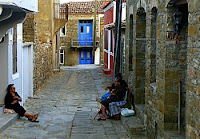The valley of Kızılçukur (Red Hollow) starts 3 km. north of Ürgüp on the Avanos road, and requires 1,5 hours to walk to lovely village square of Çavuşin.
It is a popular hiking destination. The path runs across a perfectly
sculpted lanscape of pink tufa pock marked with pigeon grids.
The cave church of St John the Baptist in Çavuşin, dated to the 5th century, is the oldest identifiable in Cappadocia. Paintings in the Güvercinlik Church
commemorate a visit by the Byzantine Emperor Nicephorus Phocas II
(963-969), a native of the region. Pigeon were cultivated in the past
for their droppings. Industrial fertilizers are now preferred.
Zelve
ucked away in the pink hills 4 km east
of Çavuşin is Zelve, the largest deserted cave community in Cappadocia.
The settlement spreads along three valleys separated by narrow ridges;
secret passageways give access from valley to valley.
Zelve started as a monastic community around the same time as Göreme. It was later taken up by the peasants who continued to live here until evicted by the government in 1952. Some indemnity suits resulting from that action still drag on in courts.
Avanos
Avanos is a local market town and
handicrafts centre. Set on the right bank of the Kızılırmak (Red River),
the old town is full of quaint balconied houses and shops emulating Ali
Baba’s treasure trove for the benefit of tourists. Most famous is the
manufacture of pottery from the red mud of the river. Some workshops are
located in labyrinth-like underground chambers. They can be toured on
request.
Tags: Ali Baba's treasure, Avanos, Byzantine Emperor Nicephorus Phocas II, Cappadocia, Cappadocia Red Hollow, Çavuşin, Güvercinlik Church, handicrafts centre, Kızılırmak, local market, Nevsehir, pigeon grids, Red Hollow, Red River, St John the Baptist, travel guide, turkey, turkey travel, turkey travel guide, village square of Çavuşin, Zelve
















